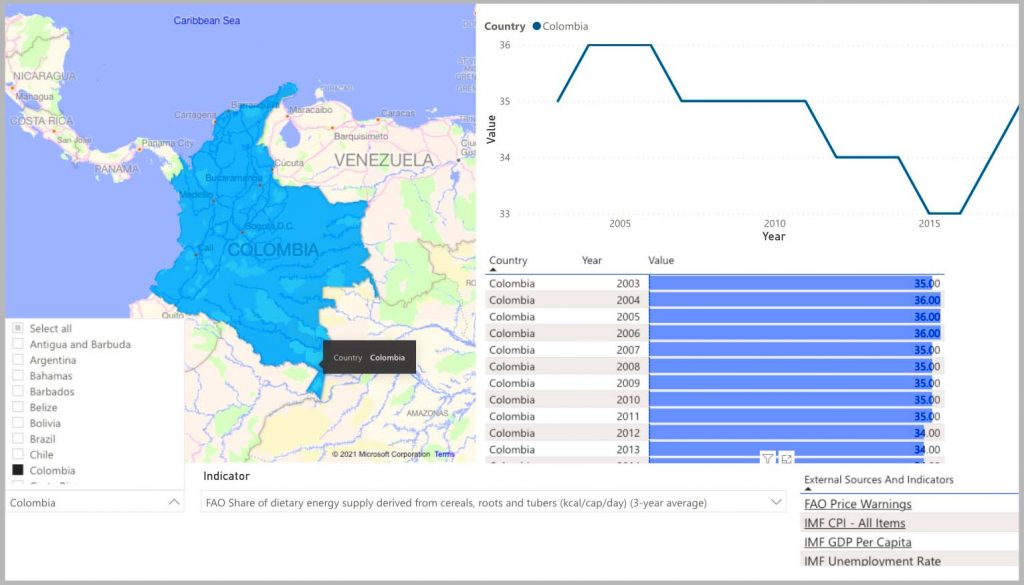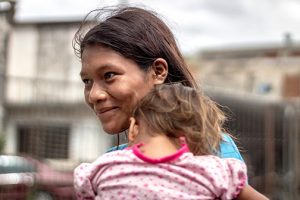Identifying Food Insecurity with Enhanced Monitoring and Reporting

Overview
The Cal Poly Digital Transformation Hub (DxHub) powered by Amazon Web Services (AWS) collaborated with staff of the World Bank’s Agriculture and Food Global Practice to design and demonstrate a dashboard that can be used to quickly and effectively monitor and report on heightened food insecurity. Tools such as this can help the World Bank and other development organizations and humanitarian assistance agencies provide critical assistance to regions and countries most in need.
Problem
 To have a holistic picture of food insecurity in a country, multiple contributing factors need to be quantified and analyzed. Agreeing on a common set of numbers is challenging, because many international development organizations, such as the World Food Programme, FAO, and the World Bank, collect their own sets of food security data. The multiple data sources, dissimilar formats, different frequencies of collection, and varying levels of quality exacerbate the problem of being able to identify early declines in food security.
World Bank staff are able to make use of the available data, but further enhancements would help meet long-term needs for systematic analysis and interpretation of the data, which is critical for understanding the drivers of food insecurity. Importantly, more robust analytical capacity would enable World Bank country teams to more quickly and effectively identify emerging food insecurity hotspots and mobilize appropriate responses.
To have a holistic picture of food insecurity in a country, multiple contributing factors need to be quantified and analyzed. Agreeing on a common set of numbers is challenging, because many international development organizations, such as the World Food Programme, FAO, and the World Bank, collect their own sets of food security data. The multiple data sources, dissimilar formats, different frequencies of collection, and varying levels of quality exacerbate the problem of being able to identify early declines in food security.
World Bank staff are able to make use of the available data, but further enhancements would help meet long-term needs for systematic analysis and interpretation of the data, which is critical for understanding the drivers of food insecurity. Importantly, more robust analytical capacity would enable World Bank country teams to more quickly and effectively identify emerging food insecurity hotspots and mobilize appropriate responses. Solution
 For data ingestion, the team worked with data sources from WFP, FAO and the World Bank, pulling in 44 indicators from 33 countries. These data sources came in multiple formats and had to be cleaned up and fit into a standard structure and CSV format using Python. Many of the indicators had different timescales and needed to be broken up to fit within a common timescale, so that they could be easily displayed on a dashboard.
For data ingestion, the team worked with data sources from WFP, FAO and the World Bank, pulling in 44 indicators from 33 countries. These data sources came in multiple formats and had to be cleaned up and fit into a standard structure and CSV format using Python. Many of the indicators had different timescales and needed to be broken up to fit within a common timescale, so that they could be easily displayed on a dashboard.
 The CSV files were then imported into PowerBI as a data source for visualization. The dashboard includes a page on each of the following: a comparison of one indicator across all countries; a comparison of all indicators and their trends within a specific country; all indicators for all countries for a given year; and data coverage for each country. World Bank staff expect to use this dashboard for internal monitoring and reporting on food security in the LAC Region going forward.
Building on the data visualization work, the students trained a model to predict food insecurity in countries in the LAC Region. Using historical data, they compared the results produced by their model with the results generated by three other regression models currently in use, to assess their relative abilities to predict GFSI scores. The findings of this exercise were written up in a paper that can be found in the “Supporting Documents” section below.
“Our team was very impressed with the Cal Poly students. Their commitment, creativity, and insight made the partnership an enriching experience for us. We hope they continue to explore data solutions to development challenges going forward in their careers,” said Leah Arabella Germer, Agriculture Analyst, Agriculture Global Practice, World Bank.
The CSV files were then imported into PowerBI as a data source for visualization. The dashboard includes a page on each of the following: a comparison of one indicator across all countries; a comparison of all indicators and their trends within a specific country; all indicators for all countries for a given year; and data coverage for each country. World Bank staff expect to use this dashboard for internal monitoring and reporting on food security in the LAC Region going forward.
Building on the data visualization work, the students trained a model to predict food insecurity in countries in the LAC Region. Using historical data, they compared the results produced by their model with the results generated by three other regression models currently in use, to assess their relative abilities to predict GFSI scores. The findings of this exercise were written up in a paper that can be found in the “Supporting Documents” section below.
“Our team was very impressed with the Cal Poly students. Their commitment, creativity, and insight made the partnership an enriching experience for us. We hope they continue to explore data solutions to development challenges going forward in their careers,” said Leah Arabella Germer, Agriculture Analyst, Agriculture Global Practice, World Bank. Supporting Documents
| Source Code | All of the code and assets developed during the course of creating the prototype. |
| Student Paper | This document was coauthored by Nathaniel Cinnamon, David Ngo, Amy Ozee and Charlie Talyor. |
About the DxHub
Cal Poly’s Digital Transformation Hub (DxHub) was one of the earliest collaborations between Amazon Web Services (AWS) and an educational institution focused on innovation and digital transformation. While providing students with real-world learning experiences, the DxHub applies proven innovation methodologies in combination with the deep subject matter expertise of the public sector and the technical expertise of AWS to solve challenging problems in ways not contemplated before. For more information, visit dxhub.calpoly.edu.
